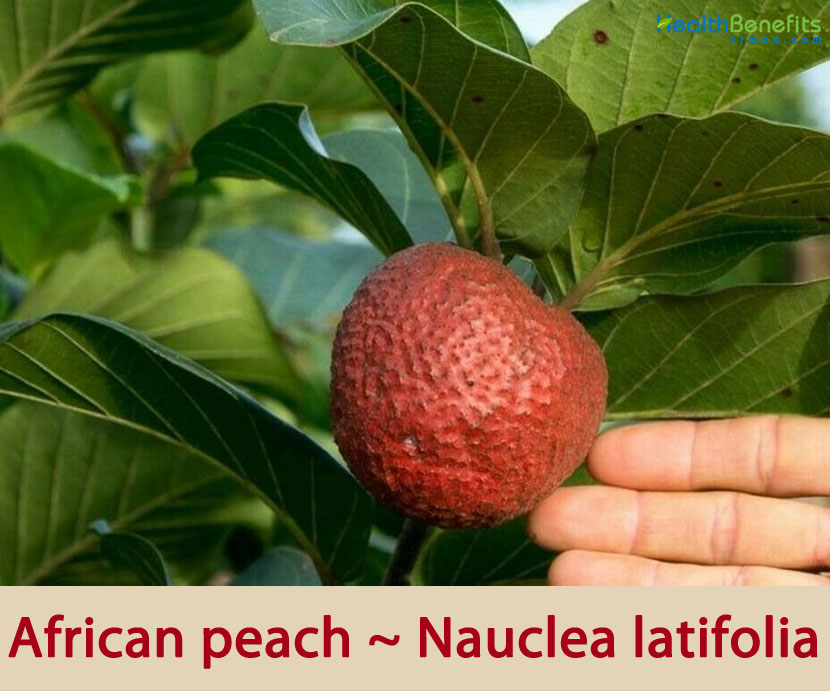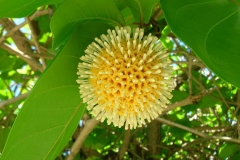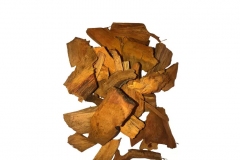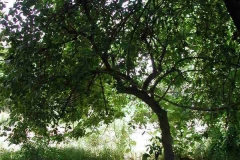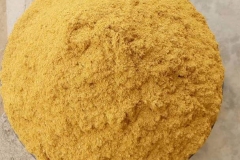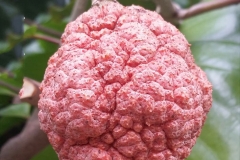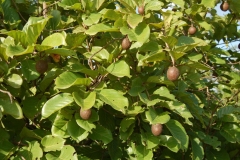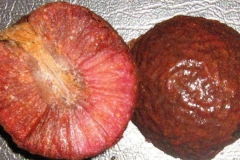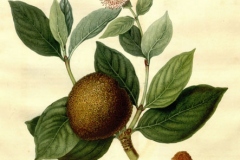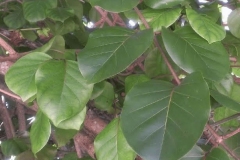| African peach Quick Facts | |
|---|---|
| Name: | African peach |
| Scientific Name: | Nauclea latifolia |
| Origin | Tropical Africa and Asia |
| Shapes | Compound fruit. The fruits are usually fleshy, shallow-pitched, with numerous embedded seeds surrounded by a pink edible, sweet- sour pulp |
| Taste | Sour (Flesh) |
| Health benefits | Support for jaundice, fever, stomach ache, dysentery, tuberculosis, asthma, bronchitis, cough, diabetes, hernia, diarrhea, piles and dental caries |
| Name | African peach |
|---|---|
| Scientific Name | Nauclea latifolia |
| Native | Tropical Africa and Asia. It is widely distributed throughout the forest and tropical forests of Benin, Burkina Faso, Cameroon, Democratic Republic of Congo, Ghana and Nigeria |
| Common Names | Pin cushion tree, Guinea peach, Sierra Leone peach, Bishop’s head, African Peach, Angatu, Chipoka, Dhiot, Ebolo, Goat, Gongan, Gounge, Guinea peach, Karmadodah, Kwomo, Logotomic, Miaar, Monyo, Mutma, Nauclea, Negro-peach, Pincushion, Rata-bakmi, Sukisia, african cinchona, african quinine, akabi awotso, banampe, bari, baro, bati country fig, brampe, country fig, country-fig, daindaté, dikabiatso, doundake, doundaké, ebele, ebeliodole, ebolo, edoil, egbesi, egbessi root, ekomokoi, ekusiawa, eomokoi, eutukidole, galun gun, guinea peach, guineapeach fathead tree, gulun gun, hwene hwenti, kankanu, katama, kina du rio nunez, kisia, kuru kuntu, kusia, lago, molo, munyu, mutamatama, mutma, nauclea, negro peach, nemo, njimo, nyimo, opepe, osupuwa, owentin, oyefa oshwefa, oyefa tshofa, peachroot, peyae biasa, pêcher africain, sarcocephalus latifolius, sierra leone peach, sierra leone-peach, supaka, tafashia, tafashia. telede, tshofa tshuru, woacroolie root, wuacruli |
| Name in Other Languages | Benin: koma Cameroon: Koumkouma English: African cinchona, African peach, African quinine, Doundake bark, Doundaki bark, Guinea peach, Negro peach, Sierra Leone peach, Country fig, Strawberry tree, pincushion tree French: Kina du Rio Nunez, Liane à fraises, Liane-fraise, Pêcher africain, Quinquina africaine, Scille maritime, oignon marine, medicinal squill Guinea: Badi, bahi, baro, bati, doudé, dundaké, dundé, dundu badi, dunndukké, edjik, kulundo, mon leuth, nandok Guinea: Bissa, dundakhé Hausa: Tafashiya, tashiyaigia, tafiyaigia, Marga, tabashiya, tuwon biri Hindi: Edjik, mon leuth Ibibio: Mbom-ibong Igede (Benue): Uche Igbo: Ubulu inu, Uvuru-ilu Itsekiri: Itu Kilba: Molsa Mali: Badi, bahi, baro, bati, dundu badi Russian: Naukleya shirokolistnaya (Науклея широколистная) Sierra Leone: Doudé, dundaké, dundé, kulundo, nandok Spanish: Nijmo Togo: koma Uganda: Kibuki-lingi, kilingi Yoruba: Egbẹsi |
| Plant Growth Habit | Spreading, evergreen, multi-stemmed deciduous, shrub or small tree |
| Growing Climates | Dry savannah and thickets, undisturbed fringing forest, closed savannah woodland |
| Plant Size | Varies widely in height from around 10 meters up to 30 meters according to soil and moisture conditions |
| Bark | Bark is dark gray, fibrous, and cracked |
| Leaf | Leaves are glabrous, opposite, elliptical, shortly acuminate, obtusely narrowed or nearly rounded at the base, with about 7–8 lateral veins on each side, 2–8 inches long and 1–4 inches wide |
| Flowering season | April to June |
| Flower | Open canopy flowers with terminal spherical head like cymes of small whitish flowers. Flower head is up to 2 mm in diameter, sweet scented and sought by bees. The flowers are joined with their calyces |
| Fruit Shape & Size | Compound fruit. The fruits are usually fleshy, shallow-pitched, with numerous embedded seeds surrounded by a pink edible, sweet- sour pulp |
| Flesh | Deep red, watery |
| Seed | Small, ovoid, numerous and brownish with a pleasant taste |
| Taste | Sour |
| Plant Parts Used | Roots, stem, bark, and leaves |
| Season | July to September |
Plant Description
African peach is a spreading, evergreen, multi-stemmed deciduous, shrub or small tree with an open canopy, usually branching from low downs the bole. The tree varies widely in height from around 10 meters up to 30 meters according to soil and moisture conditions. The plant is found growing in dry savannah and thickets, undisturbed fringing forest and closed savannah woodland. The bark is dark gray, fibrous, and cracked.
Leaves
Leaves are glabrous, opposite, elliptical, shortly acuminate, obtusely narrowed or nearly rounded at the base, with about 7–8 lateral veins on each side, 2–8 inches long and 1–4 inches wide. Petiole is 1/5– 4/5 inches long. Stipules are short, obtuse, keeled and minutely ciliate. They are shiny green with tufts of hairs, and rounded at the base but pointed at the tip.
Flowers
The plant has an open canopy flowers with terminal spherical head like cymes of small whitish flowers. Flower head is up to 2 mm in diameter, sweet scented and sought by bees. The flowers are joined with their calyces. The tree flowers from April to June.
Fruits
Fertile flowers are followed by a compound fruit. The fruits are usually fleshy, shallow-pitched, with numerous embedded seeds surrounded by a pink edible, sweet- sour pulp (a syncarp up to 3 inches in diameter). The fruits are not appealing but edible. The seeds are usually small, ovoid, numerous and brownish with a pleasant taste but could be emetic if taken in excess. The fruits ripen from July to September.
Traditional uses and benefits of African peach
- African Peach is used against various medical conditions such as fever and indigestion.
- It is used in the treatment of diabetes.
- The root is febrifuge and tonic.
- The fruit is eaten as a cure for coughs.
- The plant is commonly used as a remedy for diarrhea, pain, dental caries, septic mouth, and diabetes in several African countries.
- It is also used in the treatment of malaria, leprosy, debility, hypertension, gastrointestinal disorders, prolonged menstrual flow and sleeping sickness.
- Stem bark, and roots of the plant are used against fever, jaundice, malaria, diarrhea, dysentery, hypertension and diabetes in Nigerian traditional medicines.
- Fruits are occasionally used in the treatment of piles and dysentery.
- The plant is used in the treatment of sleeping sickness and prolonged menstrual flow.
- In Northern Nigeria, a cold infusion of the stem bark is taken as a diuretic and anti-helminthic.
- The plant is used as a chewing stick and as a remedy against stomach ache and tuberculosis in Kano (Nigeria).
- Roots and major ingredients of N. latifolia are used in treatment of respiratory illnesses such as tuberculosis, asthma, bronchitis, cough and cold in Niger State.
- In Hong, Adamawa State, concoctions, infusions, and decoctions from stem bark and roots are used against jaundice, fever, stomach ache, and dysentery.
- Decoction from the leaf is used to treat fever, filariasis, and chicken pox while the stem bark is used to treat infertility in Benue State.
- Stem bark either as an infusion or decoction is used as anti-malaria, antipyretic and aphrodisiac.
- Root bark is used as tonic, antipyretic, antidepressant and analgesic.
- Leaf has the potential to relieve dysentery and diarrhea.
- The indigenous people of Abia State in South-East, Nigeria use it extensively for management and treatment of gastrointestinal ulcers.
- Parts of the plant are commonly recommended traditionally as a remedy for diabetes mellitus.
- Decoction made from the bark is described as a wash or a beverage for the treatment of jaundice.
- Decoction prepared from small piece of root is taken as a beverage for two weeks for the treatment of hernia.
- Decoction is prepared from the leaves to treat constipation in Sierra Leone.
- In Northern Nigeria, a cold infusion is taken to treat common digestive system problems.
- In West Africa, Bitter root or root bark is used to treat digestive disorders, but it sometimes causes diarrhea.
- Defoliated branches are used as a chew stick by humans for the prevention of caries.
- Roots are made into a paste and applied to treat rashes by igala people of northern Nigeria.
- Igala people of Northern Nigeria cover the birth stool with leaves to assist childbirth.
- Roots are used in the Congo for sexual asthenia (loss of strength).
- African peach plant is used as a tonic and fever medicine, chewing stick, toothaches, dental caries, septic mouth and diarrhea.
- The plant is also used in the treatment of ailments like malaria, gastro intestinal tract disorders, sleeping sickness, prolong menstrual flow, hypertension and as a chewing stick.
Culinary Uses
- Flower can be cooked and consumed as vegetable.
- Fruit can be consumed raw.
- The pulp is deep red, watery, and sweet with a taste of ripe apple.
- Fruit is said to resemble a strawberry in taste and texture.
- Flower heads can be cooked and eaten as a vegetable.
- In Sudan, ripe fruits are eaten and soft drinks are prepared from these fruits while over-ripe fruits are sometimes dried and a powder is prepared from them and used as a base for soft drinks.
Other Facts
- It can also be used as windbreak and/or planted for soil conservation.
- It is a suitable species for planting schemes for conservation and soil stabilization.
- The tree offers shade and acts as a windbreak.
- It is used as a live stake to provide barriers in farms.
- The leaves are used as mulch.
- Small twigs are used as chewing sticks.
- The bark is a source of tannins.
- A yellow dye is obtained from the roots.
- The heartwood is dark red-brown, hard and moderately heavy.
- The wood is resistant to termites.
- It is used for inlay work.
- The wood is used for fuel.
References:
https://pfaf.org/user/Plant.aspx?LatinName=Nauclea+latifolia
https://www.cabi.org/isc/datasheet/35762
https://gd.eppo.int/taxon/NUCLA
http://article.sapub.org/10.5923.j.plant.20160602.03.html
http://tropical.theferns.info/viewtropical.php?id=Nauclea+latifolia


